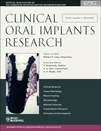Osseointegration of commercial microstructured titanium implants incorporating magnesium: a histomorphometric study in rabbit cancellous bone
Abstract
Objective: Recent studies have suggested that magnesium (Mg) ions exert a beneficial effect on implant osseointegration. This study assessed the osseointegration of nanoporous titanium (Ti) surface incorporating the Mg produced by hydrothermal treatment in rabbit cancellous bone to determine whether this surface would further enhance bone healing of moderately rough-surfaced implants in cancellous bone, and compared the result with commercially available micro-arc oxidized Mg-incorporated implants.
Material and methods: The Mg-incorporated Ti surfaces (RBM/Mg) were obtained by hydrothermal treatment using an alkaline Mg-containing solution on grit-blasted moderately rough (RBM) implants. Untreated RBM and recently introduced Mg-incorporated microporous Ti implants produced by micro-arc oxidation (M) were used controls in this study. The surface characteristics were evaluated by scanning electron microscopy, X-ray photoelectron spectroscopy and optical profilometry. Twenty-four threaded implants with a length of 10 mm (eight RBM implants, eight RBM/Mg implants and eight M implants) were placed in the femoral condyles of 12 New Zealand White rabbits. Histomorphometric analysis was performed 4 weeks after implantation.
Results: Hydrothermally treated and untreated grit-blasted implants displayed almost identical surface morphologies and Ra values at the micron-scale. The RBM/Mg implants exhibited morphological differences compared with the RBM implants at the nano-scale, which displayed nanoporous surface structures. The Mg-incorporated implants (RBM/Mg and M) exhibited more continuous bone apposition and a higher degree of bone-to-implant contact (BIC) than the untreated RBM implants in rabbit cancellous bone. The RBM/Mg implants displayed significantly greater BIC% than untreated RBM implants, both in terms of the all threads region and the total lateral length of implants (P<0.05), but no statistical differences were found between the RBM/Mg and M implants except BIC% values in total lateral length.
Conclusion: These results indicate that a nanoporous Mg-incorporated surface may be effective in enhancing the osseointegration of moderately rough grit-blasted implants by increasing the degree of bone−implant contact in areas of cancellous bone.
To cite this article:Park J-W, An C-H, Jeong S-H, Suh J-Y. Osseointegration of commercial microstructured titanium implants incorporating magnesium: a histomorphometric study in rabbit cancellous bone.Clin. Oral Impl. Res. 23, 2012; 294–300.doi: 10.1111/j.1600-0501.2010.02144.x




